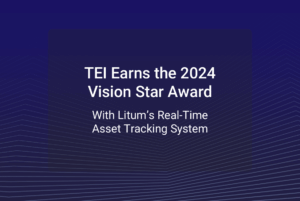Contents
In today’s fast-paced and highly competitive business landscape, maximizing efficiency is essential for staying ahead. One way to achieve this is by implementing an effective asset-tracking system that enables businesses to track and monitor their physical assets in real time. Real-time location systems (RTLS) is one such technology that has proven to deliver real results in recent years.
RTLS is a real-time tracking system that uses technologies like GNSS, RFID, and Wi-Fi to track and monitor assets accurately. It helps businesses optimize operations, reduce downtime, and improve overall efficiency.
However, understanding how asset tracking RTLS works can be challenging for those unfamiliar with the technology. In this blog post, we will explore the basics of asset tracking with RTLS and how it can help businesses maximize efficiency.
Whether you are a business owner, a logistics manager, or an operations supervisor, this post provides valuable insights into asset management and how to leverage RTLS technology to improve your business’s bottom line.
What is RTLS?
Real-time location systems (RTLS) are indoor positioning systems that locate and track assets within a defined zone covered by radiofrequency. It is an effective solution for businesses that need to keep track of their inventory or assets without manually recording their locations. By providing accurate location data, RTLS can help businesses optimize operations, reduce downtime, and improve overall efficiency.
RTLS uses technologies such as Global Navigation Satellite System (GNSS), Radio Frequency Identification (RFID), Wi-Fi, and Bluetooth low-energy (BLE) to track assets accurately in real time. GNSS is one of the most widely used tracking methods for outdoor tracking applications. It works by using satellites to pinpoint the exact location of an asset.
RFID is another popular tracking method and can be used for both indoor and outdoor applications. It uses radio waves to read tags attached to the asset and transmits information about it to a wireless receiver. Wi-Fi is mainly used for indoor asset tracking systems as it detects Wi-Fi signals from specific devices or people.
BLE technology is a wireless communication protocol designed for low power consumption and commonly used in RTLS solutions. BLE devices, such as tags and beacons, can communicate with each other within a range of up to 100 meters (328 feet), making them ideal for asset-tracking applications. In RTLS solutions, BLE tags are attached to assets such as tools, equipment, or vehicles and are tracked by BLE beacons that emit a signal. The tags pick up the signal and allow the system to determine the location of the asset.
Using these technologies, RTLS can provide businesses with an effective and reliable way to track their assets in real time. This helps them stay informed about the exact location of any asset at any given time, allowing them to make well-informed decisions that improve efficiency and productivity. It also provides businesses with valuable data regarding the movement and usage of their assets, which can be used to make further operational improvements.
Overall, RTLS is a powerful asset tracking tool that utilizes various technologies to provide accurate location data in real time. It helps businesses maximize efficiency by giving them visibility into their assets’ whereabouts and usage, enabling them to make informed decisions quickly and effectively. With its ability to provide real-time tracking and valuable data insights, RTLS is a must-have for companies looking to improve their operations and stay competitive in today’s ever-changing business landscape.
How does asset tracking RTLS work?
Asset tracking RTLS is an efficient way to monitor and control vital and valuable assets in real time. By utilizing technologies like RFID tags, GNSS, or BLE, RTLS can quickly scan and locate tagged assets in areas out of sight, providing users with near real-time inventory monitoring from any location.
The asset tracking system starts with attaching small tags to each asset, which contain unique identifying information for that asset. These tags communicate with receivers placed around the facility, sending location data back to a central server for real-time tracking.
By identifying and locating assets quickly, businesses can optimize planning and execution of tasks, leading to improved accuracy, better inventory management, efficient supply chain and operations, and improved customer service.
By consolidating all asset location data within the facility, businesses can increase efficiency, save time, and effectively manage their resources. Asset tracking with RTLS is an excellent way to maximize efficiency and optimize resource management.
Use cases for asset tracking RTLS
Now that you understand how asset tracking works with RTLS, let’s look at some other benefits of asset tracking and its common use cases.
Agriculture
The use of RTLS in asset tracking for agriculture is rapidly gaining traction as it offers an efficient way to streamline processes and maximize productivity. With RTLS, farmers can accurately track the location of their livestock, tools, and equipment, allowing for optimized scheduling of tasks such as feeding, watering, and maintenance.
Moreover, RTLS-based asset tracking provides farmers with invaluable data about the health of their livestock, enabling them to better manage resources and boost productivity.
Consumer Goods
Asset tracking RTLS is a great option for companies that produce consumer goods. With RTLS, businesses can monitor the location of their products in real time with minimal effort. This allows them to keep better track of their inventory levels and quickly update their customers on the status of their orders.
Additionally, RTLS provides valuable insights into customer behavior, enabling companies to make informed decisions about product placement and marketing campaigns.
Distribution
RTLS can be highly advantageous in the distribution industry, providing real-time insights into the location and status of assets in transit. With RTLS’s help, businesses can optimize their distribution operations, ensure timely deliveries, and streamline logistics.
For example, a company can track the location of its vehicles and assets in transit, providing real-time updates on delivery status, potential delays, and other crucial information. This lets businesses adjust their operations as needed, improving efficiency and reducing delivery times. Furthermore, asset tracking RTLS allows businesses to maintain accurate inventory records, reduce losses, and improve asset utilization, ultimately improving the bottom line.
Food & Beverage
Asset tracking RTLS is invaluable for food and beverage producers as it enables them to monitor the temperature of their products throughout the entire shipping process. This ensures that their food or drinks arrive in perfect condition at their final destination. RTLS also provides valuable insights into customer behavior, enabling companies to adjust their operations accordingly and meet customer expectations.
Healthcare
Applications of asset tracking RTLS in the healthcare industry increase efficiency and improve patient safety. It allows hospitals and clinics to accurately track the location of medical equipment and staff members in real time, enabling them to quickly respond to emergencies and better manage resources, ultimately improving patient outcomes. Additionally, asset tracking with RTLS provides valuable data about the usage of medical devices, allowing healthcare providers to optimize their budgets and reduce waste.
Hotels & Hospitality
Asset tracking RTLS proves incredibly beneficial for hotels and hospitality businesses, allowing them to manage their resources more effectively and optimize their operations. It can track the location of staff members, guests, and equipment in real time, enabling hotel managers to respond quickly to any issues. Additionally, asset tracking RTLS helps hotels and hospitality businesses improve customer experience. By tracking guests’ movements within the hotel, businesses can identify areas for improvement, such as wait times, congestion, and other issues that can affect guests satisfaction.
Manufacturing
Asset tracking RTLS allows manufacturers to monitor the location of their cargo in real time, enabling them to quickly identify potential bottlenecks in their production line and adjust accordingly. Manufacturers can benefit from asset tracking RTLS in several other ways. They can use it to track the movement of materials, components, and finished goods throughout their facilities, reducing inventory levels, improving supply chain visibility, and optimizing their production processes.
Retail
Asset tracking RTLS is utilized in retail to increase efficiency and optimize operations. It helps retailers track the location of their merchandise in real time and lets them restock shelves more quickly and manage inventory levels more efficiently.
Utilities
Utility companies often use asset tracking RTLS to monitor the real-time location of their staff members and equipment. It enables them to respond quickly to emergencies, improving overall safety and customer service.
Maximizing efficiency with asset tracking RTLS
Asset tracking RTLS is becoming increasingly popular in many industries due to some ways it can help improve efficiency and the ability to optimize operations.
Reducing Downtime and Optimizing Operations: Leveraging RTLS with asset tracking capabilities allows you to better understand the assets’ location and performance. This can reduce downtime associated with equipment malfunction or unplanned maintenance of fixed assets, improving operations’ overall efficiency.
Better Utilization of Resources: Tracking assets via RTLS leads to better utilization of resources. By understanding asset performance, businesses can ensure they get the most efficiency out of each piece of equipment and optimize operations accordingly.
Inventory Reduction: Tracking assets with RTLS also helps reduce the inventory needed to maintain operations. Assets can be tracked in real time, so businesses better understand how much is needed to keep things running smoothly. This helps them reduce costs associated with over or understocking.
Improved Maintenance Scheduling: By utilizing RTLS, companies can optimize maintenance scheduling by predicting when assets will need repairs or maintenance. This approach minimizes downtime and maximizes operational efficiency by allowing scheduled maintenance to occur before assets fail or require repair.
Better Visibility and Accountability: Lastly, an asset tracking RTLS provides better operational visibility to organizations, improving their accountability when managing assets. This ensures smoother operations and helps them stay on track with their goals.
Overall, asset tracking with an RTLS system can be a great way for businesses to maximize efficiency and optimize operations. By monitoring the location and performance of their assets, companies can utilize resources better, reduce inventory levels, and implement predictive maintenance scheduling. Furthermore, RTLS provides greater visibility and accountability when managing assets, allowing businesses streamline their operations and achieve better results. Considering its advantages, it is no wonder why asset tracking RTLS system is becoming increasingly popular across various sectors.
Litum’s RTLS asset tracking system
Litum’s RTLS Asset Tracking System is an efficient solution designed to ensure business continuity and maximize productivity. RTLS technology allows you to track your assets accurately in real-time, enabling you to better manage resources while reducing costs.
Accurate Location Detection: Litum Asset Tracking System provides location detection, allowing businesses to track the whereabouts and condition of your assets with confidence. This not only helps prevent equipment loss and reduce costs but also enables easy asset retrieval in case of misplacement. With our software, you can ensure that your assets are always accounted for and easily accessible.
Real-Time Monitoring: With our RTLS Asset Tracking System, you can enjoy real-time monitoring of your assets, providing you with an accurate and up-to-date view of their current status. This feature enables you to quickly adjust your operations and allocate resources as needed to optimize efficiency.
Zone Alerts: Litum’s RTLS Asset Tracking System provides accurate location data, making it highly effective for preventing theft and ensuring proper utilization of assets. With real-time monitoring, it can alert you if an asset enters or leaves a designated area, increasing security and visibility. Additionally, the system’s precision in tracking assets ensures the highest level of accuracy possible, making it a reliable asset tracking solution for businesses.
Employee Tracking: With our Asset Tracking RTLS, you can monitor the location, usage, and condition of your employees in real time, ensuring their safety and productivity throughout the day.
Litum’s RTLS Asset Tracking System is the ideal solution for businesses seeking to maximize efficiency with precise asset tracking information. Our cloud-based software enables you to access live data from any internet-connected device, giving you real-time visibility into the location, usage, and condition of your assets. By investing in our RTLS asset management software system, you can experience increased efficiency and optimize your operations.
Contact us to learn more about our RTLS solutions today.



